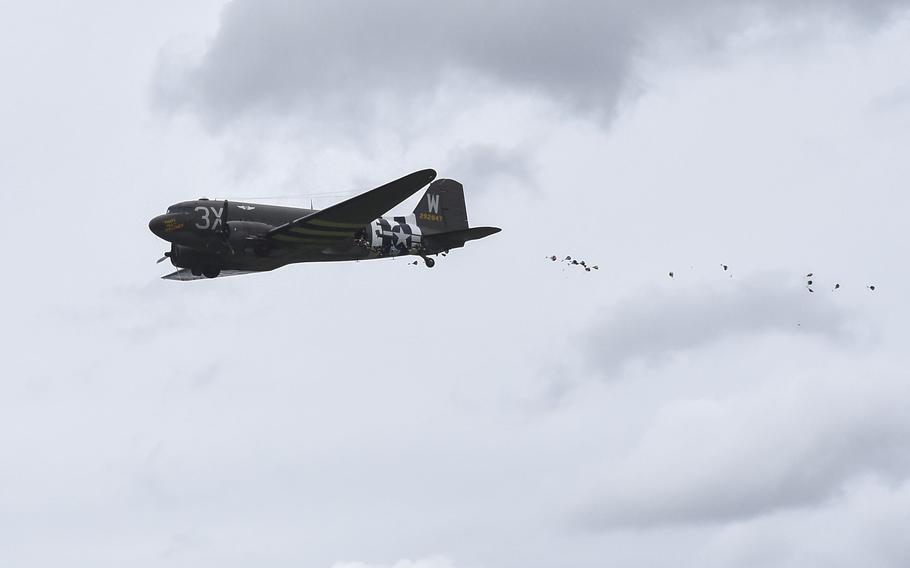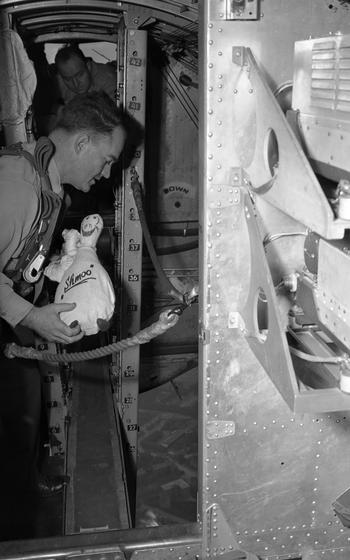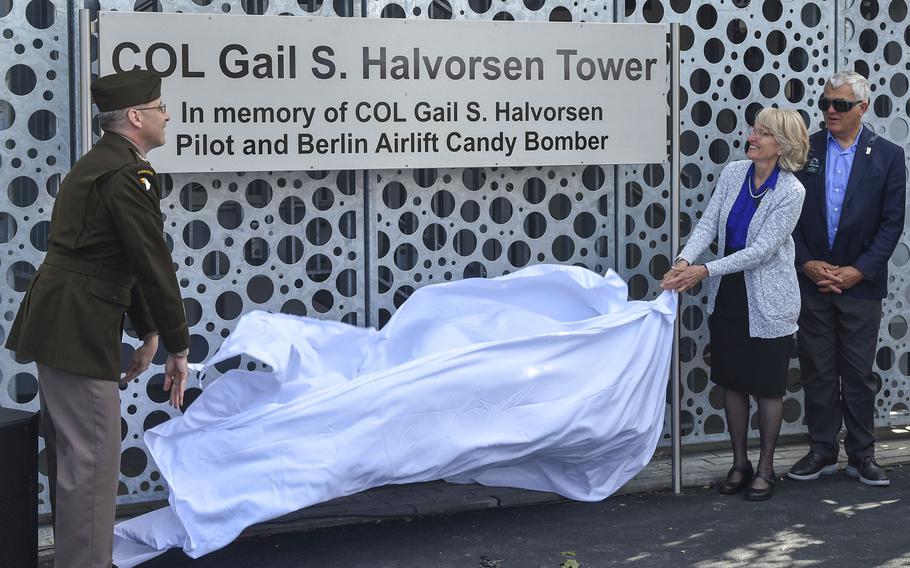
A Douglas C-47 Skytrain drops candy parachutes during the Berlin Airlift 75th anniversary commemoration on June 16, 2024, in Wiesbaden, Germany. The candy drop paid tribute to "Candy Bomber" Col. Gail Halverson and "Operation Little Vittles.” (Bradley Latham/Stars and Stripes)
WIESBADEN, Germany — Thousands of Americans and Germans gathered at Clay Kaserne over the weekend as the Army and the state of Hessen commemorated one of the largest and most significant humanitarian missions in history.
The three-day event, which ends Monday, celebrates the 75th anniversary of the end of the Berlin Airlift, an allied response to the Soviet Union’s blockade of all land and waterway access to West Berlin beginning June 24, 1948. The blockade left over 2 million residents without food and fuel supplies.
“The airlift was a historic act of humanity and solidarity in a time of hardship and suffering,” Wiesbaden Lord Mayor Gert-Uwe Mende said Saturday during the event’s opening ceremony. “The history of Wiesbaden and the U.S. Army shows us from the darkest times come the brightest moments of cooperation and understanding.”
The airlift, codenamed “Operation Vittles” and “Operation Plainfare” by the U.S. and the U.K., respectively, sent over 200,000 flights into Berlin delivering more than 2 million tons of food, coal and other supplies until the Soviet blockade lifted on May 12, 1949.
Remembrance ceremonies on Saturday and Sunday honored the roughly 75,000 personnel involved, including 86 American, British and German personnel who died in support of the mission.
“Today and every day since 1949, Wiesbaden Army Airfield has been considered hallowed ground built on its legacy as the epicenter of one of the greatest humanitarian airlifts the world has ever seen,” Wiesbaden garrison commander Col. David Mayfield said Saturday. “Let us always remember that freedom and liberty are never free. Even during this historical military operation, the peaceful use of air power did not come without a price.”
While the main U.S. effort originated out of the now closed Rhein-Main Air Base outside Frankfurt, approximately one-third of the delivered food supplies came from Wiesbaden Army Airfield, known today as Clay Kaserne, said John Provan, a historian and vice president of the Airlift Frankfurt-Berlin Association.
Additionally, the command paid tribute to “The Candy Bomber,” Col. Gail Halvorsen, with the dedication of a newly constructed air traffic control tower Saturday on Clay Kaserne. Halvorsen’s daughter, Denise Williams, spoke on the inspiration that led to Halvorsen earning his moniker.

Somewhere above Germany, Oct. 18, 1949, Capt. Eugene T. Williams, U.S. Air Force assistant German Youth Activities officer, prepares to throw a Schmoo full of candy out of the Bon Bon Bomber. The B-17 Bon Bon Bomber flew from Wiesbaden Air base to drop some 80,000 candies over displaced persons camps at Ludwigsburg, Heilbronn, and Schwabisch-Gmund. (Stars and Stripes)
While on a break between missions at Tempelhof Airport in Berlin, Halvorsen spoke to a group of children standing outside the fenced area. He offered the group his last two pieces of gum and promised them he would deliver more.
The next day, pooling rations with his fellow crewmates, he dropped the first of many payloads of sweets. The practice was quickly adopted across the force.
By the end of the airlift, crews delivered approximately 23 tons of chewing gum, chocolate and other candies.
Vera Mitschrich, who was 6 when she lived in Berlin under the flight path of Tempelhof Airport, recalled the hope and joy she and her sister felt receiving candy and supply drops.
Halvorsen was a regular attendee at Berlin Airlift commemorations, including Wiesbaden’s 70th anniversary event in 2019. He died Feb. 16, 2022, at 101 years old.
“I will never, never forget this and I am so proud of you all,” Mitschrich said to Williams on Sunday while recounting her story and honoring Halvorsen. “Your daddy gave us hope and took care of us and I will never, never forget.”
The public celebration also included static displays of historic and current military aircraft, U.S. and German army vehicles, and aerial demonstrations of vintage aircraft, including candy drops delivering approximately 10,000 pieces of candy for the young guests in attendance.
The 75th anniversary concludes Monday with a closed event for German and American students. The Wiesbaden garrison estimates it will host 50,000 visitors over the three days.

Army Col. David Mayfield and Denise Williams, daughter of “The Candy Bomber” Col. Gail Halvorsen, unveil a nameplate dedicating a new air traffic control tower in honor of Halvorsen during a ceremony June 15, 2024, on Clay Kaserne in Wiesbaden, Germany. (Bradley Latham/Stars and Stripes)